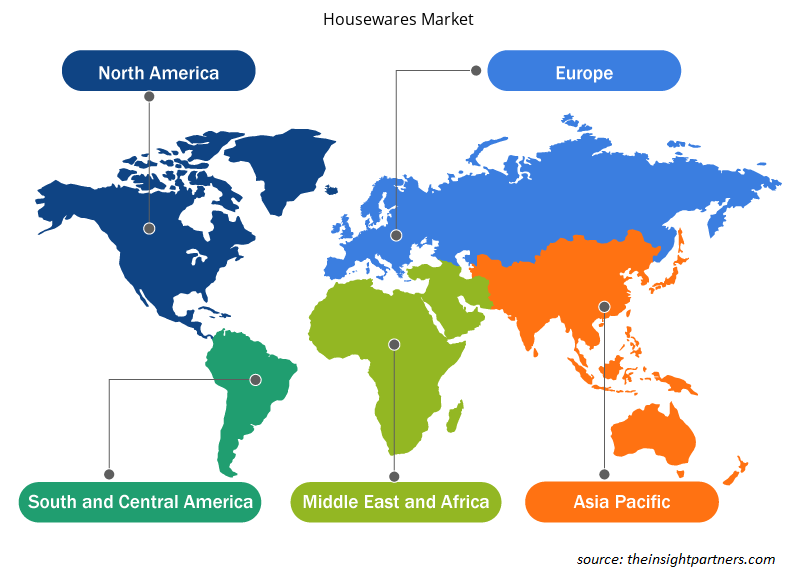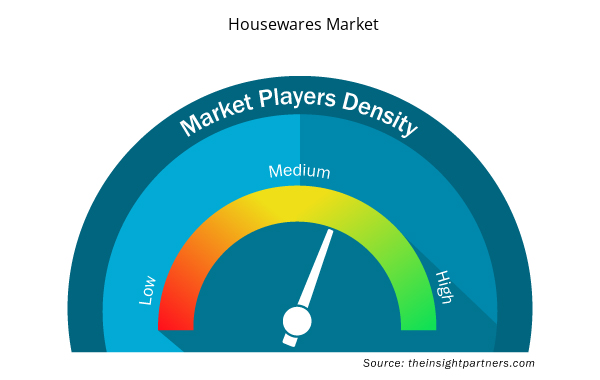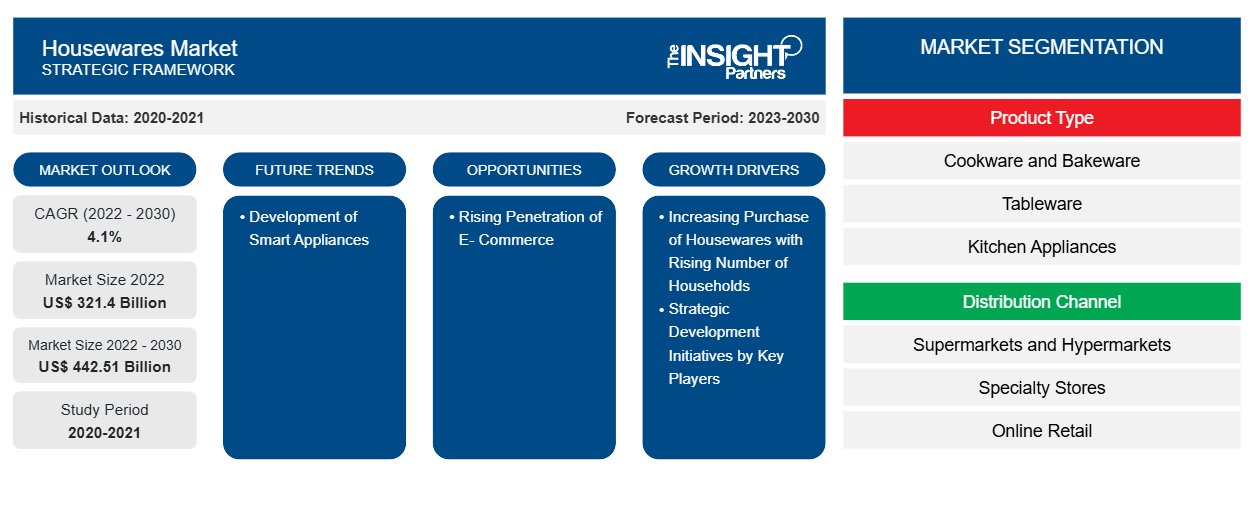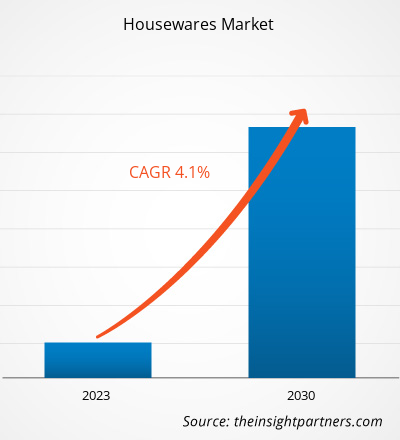[تقرير بحثي] تم تقييم حجم سوق الأدوات المنزلية بـ 321.40 مليار دولار أمريكي في عام 2022 ومن المتوقع أن يصل إلى 442.51 مليار دولار أمريكي بحلول عام 2030؛ ومن المتوقع أن يسجل معدل نمو سنوي مركب بنسبة 4.1٪ من عام 2022 إلى عام 2030.
رؤى السوق ووجهة نظر المحلل:
الأدوات المنزلية هي المنتجات والعناصر المستخدمة داخل المنزل للطهي والخبز وتنظيم المنزل، من بين أغراض أخرى. وقد شهد سوق الأدوات المنزلية نموًا مطردًا بسبب عوامل مثل أنماط الحياة المتغيرة وقضاء المزيد من الوقت في المنزل، مما أدى إلى زيادة الطلب على الأدوات المنزلية الوظيفية والجميلة. وخلال جائحة كوفيد-19، أمضى الناس المزيد من الوقت في المنزل واستثمروا في تحسين مساحات معيشتهم. بالإضافة إلى ذلك، أدى ارتفاع التجارة الإلكترونية ومنصات التسوق عبر الإنترنت إلى تسهيل وصول المستهلكين إلى مجموعة واسعة من منتجات الأدوات المنزلية وشرائها من منازلهم. هذه العوامل، إلى جانب التصميمات المبتكرة والخيارات المستدامة التي توفرها شركات الأدوات المنزلية، تعمل على توسع سوق الأدوات المنزلية.
محركات النمو والتحديات:
لقد أدت التغيرات الديناميكية في نمط الحياة وارتفاع عدد الأسر ذات الدخل المزدوج إلى ارتفاع مفاجئ في الدخول المتاحة وتحسين مستويات معيشة الأسر. ومع زيادة الدخول المتاحة، ينفق المستهلكون مبالغ كبيرة على الأدوات المنزلية والأجهزة الأخرى التي تدعم المعيشة المريحة. وهم غالبًا على استعداد لشراء منتجات جديدة نظرًا لأنماطها الفريدة، والتي تروق لشخصيتهم، مما يؤدي إلى زيادة وتيرة الشراء. وعلاوة على ذلك، فإن العدد المتزايد من الأسر المكونة من شخص واحد يثير الحاجة إلى تعديلات المنزل، وبالتالي دفع الطلب على الأدوات المنزلية مثل أدوات المطبخ وأواني الطهي وأدوات الخبز وأدوات المائدة ومستلزمات الحمام.
علاوة على ذلك، أدى ارتفاع معدلات التحضر إلى تعزيز الطلب على الوحدات السكنية، وفي النهاية، منتجات الأدوات المنزلية. ووفقًا لمكتب الإحصاء الأمريكي ووزارة الإسكان والتنمية الحضرية الأمريكية، أكملت الولايات المتحدة بناء حوالي 1.3 مليون وحدة سكنية في عام 2021، في حين كان بناء حوالي 1.7 مليون وحدة سكنية قيد التنفيذ. وبالمثل، أدى ارتفاع معدلات التحضر في الدول الأوروبية إلى خلق طلب كبير على المساكن السكنية. ووفقًا للمفوضية الأوروبية، زادت تصاريح البناء السكني بنسبة 42.3٪ من عام 2015 إلى عام 2021 في الاتحاد الأوروبي. في عام 2021، كانت فرنسا وألمانيا وبولندا مسؤولة عن معظم عمليات البدء في البناء السكني في أوروبا. وبالتالي، فإن زيادة بناء الوحدات السكنية في مختلف البلدان يعزز الطلب على الأدوات المنزلية. وبالتالي، فإن الشراء المتزايد للأدوات المنزلية جنبًا إلى جنب مع العدد المتزايد من الأسر يدفع نمو سوق الأدوات المنزلية.
ومع ذلك، فإن سوق الأدوات المنزلية مجزأة للغاية وغير منظمة بسبب العديد من الشركات الخاصة الصغيرة غير المستغلة والباعة الجائلين الذين يعملون في البلدان النامية. وفقًا لمقال نُشر في Business Standards، اعتبارًا من عام 2020، كان 80٪ من سوق أدوات المطبخ غير منظم في الهند. تستخدم الشركات الصغيرة المحلية مواد خام منخفضة الجودة لتصنيع الأدوات المنزلية مثل أدوات الطهي وأواني الخبز وإكسسوارات الحمام وأدوات المائدة. يؤدي استخدام المواد الخام منخفضة الجودة إلى منتجات نهائية رديئة الجودة وعرضة للتلف. كما تقدم الشركات المصنعة هذه المنتجات بتكاليف منخفضة؛ لذلك، يشتري غالبية المستهلكين هذه المنتجات بسبب القدرة على تحمل التكاليف وسهولة التوافر. يؤدي هذا العامل إلى انكماش قاعدة عملاء مصنعي الأدوات المنزلية الرئيسيين.
علاوة على ذلك، في كثير من الأحيان، لا يلتزم المصنعون المحليون في سوق الأدوات المنزلية غير المنظمة بالمعايير التنظيمية، مما قد يثير قضايا الجودة ويعيق تصور المستهلكين لمنتجات الأدوات المنزلية. علاوة على ذلك، فإن توافر المنتجات المقلدة يمكن أن يعيق صورة العلامة التجارية للاعبين الرئيسيين. وبالتالي، فإن الافتقار إلى التوحيد في العمليات واللوائح يعيق نمو سوق الأدوات المنزلية.
قم بتخصيص هذا التقرير ليناسب متطلباتك
ستحصل على تخصيص لأي تقرير - مجانًا - بما في ذلك أجزاء من هذا التقرير، أو تحليل على مستوى الدولة، وحزمة بيانات Excel، بالإضافة إلى الاستفادة من العروض والخصومات الرائعة للشركات الناشئة والجامعات
- احصل على أهم اتجاهات السوق الرئيسية لهذا التقرير.ستتضمن هذه العينة المجانية تحليلاً للبيانات، بدءًا من اتجاهات السوق وحتى التقديرات والتوقعات.
تقسيم التقرير ونطاقه:
يتم تقسيم سوق الأدوات المنزلية العالمية على أساس نوع المنتج وقناة التوزيع والجغرافيا. بناءً على نوع المنتج، يتم تصنيف السوق إلى أدوات الطهي وأواني الخبز وأدوات المائدة وأجهزة المطبخ ومستلزمات الحمام وغيرها. حسب قناة التوزيع، يتم تصنيف السوق إلى محلات السوبر ماركت والهايبر ماركت والمتاجر المتخصصة وتجارة التجزئة عبر الإنترنت وغيرها. حسب الجغرافيا، يتم تقسيم سوق الأدوات المنزلية العالمية على نطاق واسع إلى أمريكا الشمالية وأوروبا ومنطقة آسيا والمحيط الهادئ والشرق الأوسط وأفريقيا وأمريكا الجنوبية والوسطى.
التحليل القطاعي:
بناءً على نوع المنتج، يتم تصنيف سوق الأدوات المنزلية إلى أدوات الطهي وأواني الخبز وأدوات المائدة وأجهزة المطبخ ومستلزمات الحمام وغيرها. ومن المتوقع أن يسجل قطاع أدوات المائدة أعلى معدل نمو سنوي مركب خلال الفترة 2022-2030. يشمل قطاع أدوات المائدة منتجات مثل الأواني الفخارية وأدوات المائدة والأواني الزجاجية وأدوات التقديم. يمكن أن يُعزى الارتفاع في الطلب على أدوات المائدة في سوق الأدوات المنزلية إلى عادات تناول الطعام المتغيرة أثناء جائحة كوفيد-19. مع تناول المزيد من الناس الطعام في المنزل، بدأ الناس في التركيز على أدوات المائدة الجمالية والوظيفية، لأنها تعزز تجارب تناول الطعام في المنزل. من الوجبات اليومية إلى التجمعات الخاصة، يبحث المستهلكون عن مجموعات أدوات المائدة التي ترتقي بتجربة تناول الطعام الخاصة بهم. علاوة على ذلك، يلعب التقدير المتزايد للتصاميم الفريدة والحرفية دورًا مهمًا في دفع الطلب على أدوات المائدة. ينجذب المستهلكون بشكل متزايد إلى قطع أدوات المائدة المصنوعة يدويًا والمستوحاة من الفن والتي تضفي لمسة من الفردية والشخصية على إعدادات تناول الطعام الخاصة بهم. وبالتالي، ساهم التحول نحو خيارات أدوات المائدة الأكثر تخصيصًا وجاذبية بصريًا في تقدم سوق أدوات المائدة. تعد Vivo - Villeroy & Boch Group وCorelle وPyrex وLuminarc وSchott Zwiesel من بين اللاعبين البارزين العاملين في سوق أدوات المائدة.
التحليل الإقليمي:
تم تقسيم سوق الأدوات المنزلية إلى خمس مناطق رئيسية: أمريكا الشمالية وأوروبا وآسيا والمحيط الهادئ وأمريكا الجنوبية والوسطى والشرق الأوسط وأفريقيا. سيطرت منطقة آسيا والمحيط الهادئ على سوق الأدوات المنزلية العالمية في عام 2022 حيث بلغت قيمة السوق في هذه المنطقة 120.63 مليار دولار أمريكي في ذلك العام. تعد أوروبا ثاني أكبر مساهم، حيث تمتلك أكثر من 23٪ من حصة السوق العالمية. ومن المتوقع أن تسجل منطقة آسيا والمحيط الهادئ معدل نمو سنوي مركب كبير يتجاوز 5٪ خلال الفترة 2022-2030. يعد التوسع الحضري المتزايد والدخل المتاح لسكان الطبقة المتوسطة عاملاً رئيسيًا يدفع الطلب على الأدوات المنزلية الحديثة والمريحة، بما في ذلك الأجهزة المطبخية المتقدمة وأدوات المائدة الأنيقة.
رؤى إقليمية حول سوق الأدوات المنزلية
لقد قام المحللون في Insight Partners بشرح الاتجاهات والعوامل الإقليمية المؤثرة على سوق الأدوات المنزلية طوال فترة التوقعات بشكل شامل. يناقش هذا القسم أيضًا قطاعات سوق الأدوات المنزلية والجغرافيا في جميع أنحاء أمريكا الشمالية وأوروبا ومنطقة آسيا والمحيط الهادئ والشرق الأوسط وأفريقيا وأمريكا الجنوبية والوسطى.

- احصل على البيانات الإقليمية المحددة لسوق الأدوات المنزلية
نطاق تقرير سوق الأدوات المنزلية
| سمة التقرير | تفاصيل |
|---|---|
| حجم السوق في عام 2022 | 321.4 مليار دولار أمريكي |
| حجم السوق بحلول عام 2030 | 442.51 مليار دولار أمريكي |
| معدل النمو السنوي المركب العالمي (2022 - 2030) | 4.1% |
| البيانات التاريخية | 2020-2021 |
| فترة التنبؤ | 2023-2030 |
| القطاعات المغطاة | حسب نوع المنتج
|
| المناطق والدول المغطاة | أمريكا الشمالية
|
| قادة السوق وملفات تعريف الشركات الرئيسية |
|
كثافة اللاعبين في السوق: فهم تأثيرها على ديناميكيات الأعمال
يشهد سوق الأدوات المنزلية نموًا سريعًا، مدفوعًا بالطلب المتزايد من جانب المستخدم النهائي بسبب عوامل مثل تفضيلات المستهلكين المتطورة والتقدم التكنولوجي والوعي المتزايد بفوائد المنتج. ومع ارتفاع الطلب، تعمل الشركات على توسيع عروضها والابتكار لتلبية احتياجات المستهلكين والاستفادة من الاتجاهات الناشئة، مما يؤدي إلى زيادة نمو السوق.
تشير كثافة اللاعبين في السوق إلى توزيع الشركات أو المؤسسات العاملة في سوق أو صناعة معينة. وهي تشير إلى عدد المنافسين (اللاعبين في السوق) الموجودين في مساحة سوق معينة نسبة إلى حجمها أو قيمتها السوقية الإجمالية.
الشركات الرئيسية العاملة في سوق الأدوات المنزلية هي:
- برادشو هوم إنك
- شركة دينبي للفخار المحدودة
- شركة إتش إف كورز المحدودة
- شركة انتر ايكيا القابضة
- شركة هوتزلر للتصنيع المحدودة
إخلاء المسؤولية : الشركات المذكورة أعلاه ليست مرتبة بأي ترتيب معين.

- احصل على نظرة عامة على أهم اللاعبين الرئيسيين في سوق الأدوات المنزلية
تأثير جائحة كوفيد-19:
أعاقت جائحة كوفيد-19 في البداية سوق الأدوات المنزلية العالمية بسبب إغلاق وحدات التصنيع ونقص العمالة وتعطل سلاسل التوريد وعدم الاستقرار المالي. أدى تعطيل العمليات في مختلف الصناعات بسبب التباطؤ الاقتصادي الناجم عن تفشي كوفيد-19 إلى تقييد إمدادات الأدوات المنزلية. علاوة على ذلك، تم إغلاق العديد من المتاجر، مما حد من مبيعات الأدوات المنزلية. ومع ذلك، بدأت الشركات في اكتساب أرضية حيث تم إلغاء القيود المفروضة سابقًا في مختلف البلدان في عام 2021. علاوة على ذلك، أدى تنفيذ حملات التطعيم ضد كوفيد-19 من قبل حكومات بلدان مختلفة إلى تخفيف الوضع، مما أدى إلى ارتفاع الأنشطة التجارية في جميع أنحاء العالم. سجلت العديد من الأسواق، بما في ذلك سوق الأدوات المنزلية، نموًا بعد تخفيف عمليات الإغلاق والقيود على الحركة.
المنافسة والشركات الرئيسية:
تعد شركة Bradshaw Home Inc، وDenby Pottery، وHF Coors Co Inc، وInter Ikea Holding Bv، وHutzler Manufacturing Co Inc، وTTK Prestige Ltd، وNewell Brands Inc، وBSH Hausgerate GmbH، وKohler Co، وHaier US Appliance Solutions Inc من بين اللاعبين البارزين الذين يعملون في سوق الأدوات المنزلية العالمية.
- التحليل التاريخي (سنتان)، السنة الأساسية، التوقعات (7 سنوات) مع معدل النمو السنوي المركب
- تحليل PEST و SWOT
- حجم السوق والقيمة / الحجم - عالميًا وإقليميًا وقطريًا
- الصناعة والمنافسة
- مجموعة بيانات Excel


- Smart Water Metering Market
- Europe Tortilla Market
- Water Pipeline Leak Detection System Market
- Ceramic Injection Molding Market
- Asset Integrity Management Market
- Sleep Apnea Diagnostics Market
- Underwater Connector Market
- Pharmacovigilance and Drug Safety Software Market
- Medical Second Opinion Market
- Flexible Garden Hoses Market

Report Coverage
Revenue forecast, Company Analysis, Industry landscape, Growth factors, and Trends

Segment Covered
This text is related
to segments covered.

Regional Scope
North America, Europe, Asia Pacific, Middle East & Africa, South & Central America

Country Scope
This text is related
to country scope.
الأسئلة الشائعة
Based on distribution channel, the housewares market is segmented into supermarkets and hypermarkets, specialty stores, online retail, and others. Buying convenience and accessibility are the significant characteristics of supermarkets and hypermarkets. These stores are typically located in areas that are easily accessible by the masses, making it convenient for customers to check and purchase housewares alongside completing the planned shopping. Many supermarkets and hypermarkets have introduced their private label houseware brands, offering consumers superior-quality products at competitive prices. Supermarkets and hypermarkets have extended operating hours, which allows customers to shop at convenient hours. Also, these larger retail establishments often have the advantage of bulk purchasing power, which allows them to offer products at competitive prices. Moreover, supermarkets and hypermarkets tend to stock a variety of houseware in different product types, brands, and varieties, providing customers with a more elaborate range of selections. Walmart, Costco Wholesale Corporation, Tesco, Target, and Bed Bath & Beyond are some of the supermarkets and hypermarket stores offering houseware products.
The major players operating in the global housewares market are Bradshaw Home Inc, Denby Pottery, HF Coors Co Inc, Inter Ikea Holding Bv, Hutzler Manufacturing Co Inc, TTK Prestige Ltd, Newell Brands Inc, BSH Hausgerate GmbH, Kohler Co, and Haier US Appliance Solutions Inc among others.
Dynamic changes in lifestyle and the rising dual income families led to an upsurge in disposable incomes and improved living standards of households. With increasing disposable incomes, consumers spend significant amounts on housewares and other appliances supporting convenient living. They are often willing to purchase new products owing to their unique styles, which appeal to their individuality, resulting in a higher buying frequency. Moreover, a burgeoning number of single-person households triggers the need for home modifications, thereby driving the demand for housewares such as kitchen appliances, cookware, bakeware, tableware, and bathroom essentials. Further, a rise in urbanization has been bolstering the demand for residential units and, ultimately, homewares products. As per the US Census Bureau and the US Department of Housing and Urban Development, the US completed construction of ~1,337,800 housing units in 2021, whereas construction of 1,702,000 housing units was in progress. Similarly, rising urbanization in European countries has created a huge demand for residential housing. For instance, according to the European Commission, between 2015 to 2021, residential building permits increased by 42.3%. In 2021, France, Germany, and Poland had the most residential construction starts in Europe. Thus, the increasing construction of housing units across various countries further boosts the demand for housewares.
Smart appliances can be operated using smartphones or tablets connected via Bluetooth, near–field communication (NFC), or Wi-Fi. These technologies allow users to control their smart appliances via an app. Manufacturers are continuously modifying and developing smart home appliances to support easy lifestyles, which especially appeals to tech-savvy consumers. Well-known brands have been developing devices with automation and hi-tech features for smart homes. Moreover, voice assistants and artificial intelligence (AI) are bringing significant evolution into smart housewares.
Energy-saving appliances, notifications enabled on connected devices, and Wi-Fi capabilities are the key functional upgrades in smart kitchen appliances. For example, smart microwaves can seamlessly download cooking instructions, read barcodes on food products, and offer AI voice assistants to enable a completely hands-free experience. Whirlpool, in January 2022, announced that some of its smart, Wi-Fi-connected microwave would be upgraded to incorporate an air fry mode via a software update to replicate the crispy reheating specifications. Thus, the incorporation of innovative technologies into housewares is likely to bring new trends in the housewares market in the coming years.
Based on product type, the housewares market is categorized into cookware and bakeware, tableware, kitchen appliances, bathroom essentials, and others. The tableware segment is expected to register the highest CAGR during 2022–2030. The tableware segment includes products such as crockery, cutlery, glassware, and serveware. A surge in demand for tableware in the housewares market can be attributed to transformed dining habits during the COVID-19 pandemic. With more people dining at home, people have started focusing on aesthetic and functional tableware, as it enhances home dining experiences. From everyday meals to special gatherings, consumers are looking for tableware sets that elevate their dining experience. Furthermore, the growing appreciation for unique and artisanal designs plays a significant role in driving the demand for tableware. Consumers are increasingly drawn to handcrafted and artistically inspired tableware pieces that bring a touch of individuality and personality to their dining settings. Thus, a shift toward more personalized and visually striking tableware choices has contributed to the progress of the housewares market for the tableware segment. Vivo - Villeroy & Boch Group, Corelle, Pyrex, Luminarc, and Schott Zwiesel are a few of the prominent players operating in the market for tableware.
Trends and growth analysis reports related to Consumer Goods : READ MORE..
The List of Companies - Houseware Market
- Bradshaw Home Inc
- The Denby Pottery Co Ltd
- HF Coors Co Inc
- Inter Ikea Holding Bv
- Hutzler Manufacturing Co Inc
- TTK Prestige Ltd, Newell Brands Inc
- BSH Hausgerate Gmbh
- Kohler Co
- Haier US Appliance Solutions Inc.
The Insight Partners performs research in 4 major stages: Data Collection & Secondary Research, Primary Research, Data Analysis and Data Triangulation & Final Review.
- Data Collection and Secondary Research:
As a market research and consulting firm operating from a decade, we have published and advised several client across the globe. First step for any study will start with an assessment of currently available data and insights from existing reports. Further, historical and current market information is collected from Investor Presentations, Annual Reports, SEC Filings, etc., and other information related to company’s performance and market positioning are gathered from Paid Databases (Factiva, Hoovers, and Reuters) and various other publications available in public domain.
Several associations trade associates, technical forums, institutes, societies and organization are accessed to gain technical as well as market related insights through their publications such as research papers, blogs and press releases related to the studies are referred to get cues about the market. Further, white papers, journals, magazines, and other news articles published in last 3 years are scrutinized and analyzed to understand the current market trends.
- Primary Research:
The primarily interview analysis comprise of data obtained from industry participants interview and answers to survey questions gathered by in-house primary team.
For primary research, interviews are conducted with industry experts/CEOs/Marketing Managers/VPs/Subject Matter Experts from both demand and supply side to get a 360-degree view of the market. The primary team conducts several interviews based on the complexity of the markets to understand the various market trends and dynamics which makes research more credible and precise.
A typical research interview fulfils the following functions:
- Provides first-hand information on the market size, market trends, growth trends, competitive landscape, and outlook
- Validates and strengthens in-house secondary research findings
- Develops the analysis team’s expertise and market understanding
Primary research involves email interactions and telephone interviews for each market, category, segment, and sub-segment across geographies. The participants who typically take part in such a process include, but are not limited to:
- Industry participants: VPs, business development managers, market intelligence managers and national sales managers
- Outside experts: Valuation experts, research analysts and key opinion leaders specializing in the electronics and semiconductor industry.
Below is the breakup of our primary respondents by company, designation, and region:

Once we receive the confirmation from primary research sources or primary respondents, we finalize the base year market estimation and forecast the data as per the macroeconomic and microeconomic factors assessed during data collection.
- Data Analysis:
Once data is validated through both secondary as well as primary respondents, we finalize the market estimations by hypothesis formulation and factor analysis at regional and country level.
- Macro-Economic Factor Analysis:
We analyse macroeconomic indicators such the gross domestic product (GDP), increase in the demand for goods and services across industries, technological advancement, regional economic growth, governmental policies, the influence of COVID-19, PEST analysis, and other aspects. This analysis aids in setting benchmarks for various nations/regions and approximating market splits. Additionally, the general trend of the aforementioned components aid in determining the market's development possibilities.
- Country Level Data:
Various factors that are especially aligned to the country are taken into account to determine the market size for a certain area and country, including the presence of vendors, such as headquarters and offices, the country's GDP, demand patterns, and industry growth. To comprehend the market dynamics for the nation, a number of growth variables, inhibitors, application areas, and current market trends are researched. The aforementioned elements aid in determining the country's overall market's growth potential.
- Company Profile:
The “Table of Contents” is formulated by listing and analyzing more than 25 - 30 companies operating in the market ecosystem across geographies. However, we profile only 10 companies as a standard practice in our syndicate reports. These 10 companies comprise leading, emerging, and regional players. Nonetheless, our analysis is not restricted to the 10 listed companies, we also analyze other companies present in the market to develop a holistic view and understand the prevailing trends. The “Company Profiles” section in the report covers key facts, business description, products & services, financial information, SWOT analysis, and key developments. The financial information presented is extracted from the annual reports and official documents of the publicly listed companies. Upon collecting the information for the sections of respective companies, we verify them via various primary sources and then compile the data in respective company profiles. The company level information helps us in deriving the base number as well as in forecasting the market size.
- Developing Base Number:
Aggregation of sales statistics (2020-2022) and macro-economic factor, and other secondary and primary research insights are utilized to arrive at base number and related market shares for 2022. The data gaps are identified in this step and relevant market data is analyzed, collected from paid primary interviews or databases. On finalizing the base year market size, forecasts are developed on the basis of macro-economic, industry and market growth factors and company level analysis.
- Data Triangulation and Final Review:
The market findings and base year market size calculations are validated from supply as well as demand side. Demand side validations are based on macro-economic factor analysis and benchmarks for respective regions and countries. In case of supply side validations, revenues of major companies are estimated (in case not available) based on industry benchmark, approximate number of employees, product portfolio, and primary interviews revenues are gathered. Further revenue from target product/service segment is assessed to avoid overshooting of market statistics. In case of heavy deviations between supply and demand side values, all thes steps are repeated to achieve synchronization.
We follow an iterative model, wherein we share our research findings with Subject Matter Experts (SME’s) and Key Opinion Leaders (KOLs) until consensus view of the market is not formulated – this model negates any drastic deviation in the opinions of experts. Only validated and universally acceptable research findings are quoted in our reports.
We have important check points that we use to validate our research findings – which we call – data triangulation, where we validate the information, we generate from secondary sources with primary interviews and then we re-validate with our internal data bases and Subject matter experts. This comprehensive model enables us to deliver high quality, reliable data in shortest possible time.


 احصل على عينة مجانية لهذا التقرير
احصل على عينة مجانية لهذا التقرير